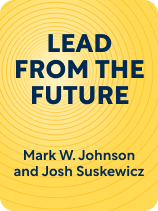

This article is an excerpt from the Shortform book guide to "Lead From the Future" by Mark W. Johnson and Josh Suskewicz. Shortform has the world's best summaries and analyses of books you should be reading.
Like this article? Sign up for a free trial here.
In which directions might you pursue growth for your business? How does knowing your growth gap help you plan?
Once you have a vision for your business, you must convert it into a strategy that will bring your vision to life. According to the authors of Lead From the Future, your strategy must contain a long-term financial picture of your business. This requires you to determine your growth target and growth gap.
Read more to learn how to develop your business’s long-range financial outlook.
Your Business’s Financial Future
Developing a long-term financial picture helps you estimate the revenue and profits your future vision will likely yield. To develop this component of your visionary strategy, you must first identify a growth target that aligns with your future vision, then calculate what the authors call your growth gap and figure out when your growth gap is likely to develop.
Your growth target is an aspirational revenue and profit benchmark for your company at your target time horizon (for example, your growth target could be to increase your revenue by a certain percentage over the next decade). When identifying a growth target, consider the different areas in which you could pursue growth. You can improve or change your core product or offer supplements to the core product. You might also develop all new products.
(Shortform note: In Blitzscaling, Reid Hoffman argues that online businesses do not benefit from engaging in time-consuming computations about aspirational revenue goals and potential areas of growth. This is because such an approach could potentially place you in a disadvantageous position due to rapidly changing market dynamics, rendering your product outdated. Reid explains that growing quickly as an internet-based business requires that you move quickly and that taking a cautious, calculating approach can quickly make you lose ground amongst your competitors or make your company obsolete.)
After selecting an ambitious but practical growth target, discuss and decide how much growth your core and proximate businesses can realistically deliver by your target time horizon. With this information, you can calculate your growth gap—the difference between what you aspire to deliver and what you are likely to deliver, given your current status. Knowing your growth gap helps you determine how fast and large any new innovative business ventures must be to reach your growth target.
(Shortform note: As a leader, considering your personal growth gap might also be valuable. In Daring Greatly, Brené Brown discusses a growth gap that occurs in people’s lives—a space between where you are in your life now and where you want to be. Brown explains that acknowledging this gap is crucial for personal growth and development. Rather than avoiding or dismissing the discomfort that arises from this disparity, she encourages people to explore their aspirations and the steps required to bridge the gap. By mindfully acknowledging your personal growth gap and actively working towards closing it, you can cultivate resilience and the courage to pursue your authentic desires.)

———End of Preview———
Like what you just read? Read the rest of the world's best book summary and analysis of Mark W. Johnson and Josh Suskewicz's "Lead From the Future" at Shortform.
Here's what you'll find in our full Lead from the Future summary:
- Why it's important to anticipate future change rather than reacting to it
- A three-stage framework for staying ahead of the competition
- How to understand and adopt the visionary planning process






